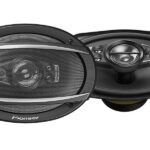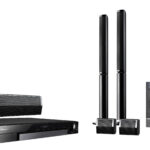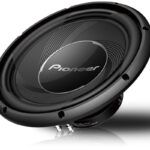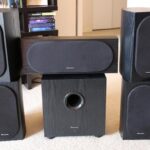When it comes to determining if subs are broken, the simplest way is to check for visible physical damage or loss of sound. Subs may show signs of cracks, tears, or holes on the cone or surround, and may produce distorted or no sound.
Subwoofers are an essential component of any audio system, enhancing the low-frequency output to provide a richer and more immersive auditory experience. However, like any electronic device, subs can sometimes encounter issues, such as being broken or damaged. Recognizing when subs are broken is crucial in order to ensure optimal audio performance.
Fortunately, there are several telltale signs that can help you identify a broken subwoofer. By being vigilant and observant, you can easily determine whether your subwoofers are in proper working condition or if they require repairs or replacements. We will discuss some effective methods to detect broken subs, helping you troubleshoot common problems and maintain the integrity of your audio setup.
Signs Of Broken Subs In
If you’re experiencing issues with your subs, it’s important to identify the signs of a malfunctioning unit. One common indication is uneven sound output, where certain frequencies are louder or quieter than others. This can result in an imbalanced audio experience that detracts from the overall quality. Another telltale sign is distorted or crackling audio, which can occur when the subwoofer’s cone or voice coil is damaged. When playing music or videos, if you notice any abnormal sound disruptions, it’s likely there’s a problem with your subs. It’s important to address these issues promptly, as continuing to use broken subs can lead to further damage and potential harm to your audio system. Consider consulting a professional or referring to the manufacturer’s troubleshooting guide for specific advice on how to fix or replace your subs.

Lack Of Functionality
How to Tell When Subs are Broken In
One way to determine if subs are broken is through a lack of functionality. If subs are not responding to input signals, this can indicate a problem. When activated, if no sound is produced, it may suggest malfunctioning subs. This lack of response and output can be a clear sign that the subs are broken and need attention.
Uneven Sound Output
Have you noticed that your subwoofers are producing sound at varying volumes? This can be an indication that your subs are broken and in need of repair or replacement. Inconsistent bass levels can be frustrating for any audio enthusiast, as it detracts from the overall listening experience.
When subwoofers are not functioning properly, you may notice that some songs or movies have overpowering bass while others are lacking in low-end frequencies. This inconsistency can result from issues such as damaged voice coils or worn-out components within the subwoofers.
It is essential to address these issues promptly to ensure a balanced and immersive sound experience. If you are unsure whether your subs are broken, consider consulting a professional audio technician who can diagnose the problem and provide the necessary solutions.
Distorted Or Crackling Audio
When it comes to identifying broken subs, one common sign is the presence of distorted or crackling audio. If your subs are emitting a distorted or muffled sound, it could indicate a problem. Another noticeable issue is the occurrence of crackling or popping noises from the subs. These noises can be disruptive and affect the overall audio quality.
Common Causes Of Broken Subs
How to Tell When Subs are Broken in
Overloading of the subwoofer
Subwoofers are designed to handle a certain amount of power. When you exceed the recommended power limits, you risk damaging the subwoofer. Signs of overloading include distortion, crackling sounds, and reduced bass response. To avoid this, make sure to match the subwoofer’s power handling capabilities with the amplifier or receiver.
Damage to the subwoofer cone
The subwoofer cone is a vital component responsible for producing sound. Physical damage such as holes, tears, or deformities can impair the subwoofer’s performance. If you notice abnormal sounds or reduced bass output, inspect the cone for any visible damage.
Faulty amplifier or receiver
An amplifier or receiver that is malfunctioning can negatively affect the performance of your subwoofer. Check if the connections are secure and that the amplifier or receiver is producing the correct output. Incorrect wiring or electrical issues can lead to subwoofer failure. Consider consulting a professional if you suspect your amplifier or receiver is faulty.
Overloading Of The Subwoofer
Too much pressure on a subwoofer can cause it to break down. When you overload a subwoofer by pushing it beyond its power limits or overdriving it with excessive volume, you risk damaging its components. This can result in distorted sound, loss of bass, or even complete failure of the subwoofer. To avoid this, it is important to be mindful of the power ratings and limitations of your subwoofer, as well as the capabilities of your audio system. Ensure that the subwoofer is not being operated at its maximum power for extended periods of time, as this can lead to overheating and eventual damage. Monitoring the volume levels and making adjustments accordingly can help prevent subwoofer failure.
Damage To The Subwoofer Cone
| Subtitle 2: Damage to the Subwoofer Cone |
| Physical damage to the subwoofer cone |
|
Faulty Amplifier Or Receiver
Subwoofers are an integral part of any audio setup, and it can be frustrating when they start malfunctioning. One common cause of subwoofer issues is a faulty amplifier or receiver. When your amplifier is not working properly, it can affect the performance of your subwoofer. The amplifier is responsible for sending the audio signals to the subwoofer, and if it is malfunctioning, you may experience distorted or low-quality sound. Similarly, a receiver issue can also cause problems with your subwoofer. The receiver is responsible for processing and distributing the audio signals to the appropriate speakers and subwoofer. If there are issues with the receiver, it can result in a lack of power or distorted sound from the subwoofer. Therefore, it’s important to check the amplifier and receiver if you notice any problems with your subwoofer’s performance.
Troubleshooting Broken Subs
Checking subwoofer connectionsMake sure the power cable is securely plugged into an outlet and the subwoofer is turned on. Check all the audio cables to ensure they are properly connected to both the subwoofer and the audio source. Consider using high-quality cables for optimal performance.
Adjusting subwoofer settingsAccess the audio settings on your device or amplifier and adjust the subwoofer settings. Increase the volume level of the subwoofer to see if it produces any sound. Experiment with different frequency settings to find the desired bass response.
Testing the subwoofer with another deviceConnect the subwoofer to another audio source, such as a different device or a smartphone, to determine if the issue lies with the subwoofer or the original audio source. If the subwoofer works fine with another device, it indicates a problem with the original audio source.
Checking Subwoofer Connections
|
When it comes to assessing the status of your subwoofer, it is crucial to check its connections thoroughly. Firstly, verify that the subwoofer is securely connected to the amplifier. Loose or improper connections can result in distorted sound or even complete silence. To ensure a secure connection, make sure that the cables are firmly plugged into both the subwoofer and amplifier jacks. |
|
Additionally, pay attention to the wiring of the subwoofer. Incorrect wiring can also lead to malfunctions. Double-check that the positive and negative terminals are correctly connected. Most subwoofers have color-coded terminals to assist with proper wiring – red for positive and black for negative. Take a moment to inspect the wiring and confirm that there are no frayed or damaged wires. |
Adjusting Subwoofer Settings
Adjusting the subwoofer settings is crucial to achieving the desired audio experience. When it comes to identifying broken subs, listen out for any distortion or rumbling noises. To modify the subwoofer volume, start by setting it to 50% and adjust accordingly to achieve a balanced sound. The crossover settings determine the frequency at which the subwoofer starts playing. It is important to find the right balance between the subwoofer and other speakers in your setup. To achieve this, try adjusting the crossover point to smoothly blend the low-frequency sounds. Keep in mind that a well-balanced subwoofer should enhance the audio experience, not overpower it. Experiment with different volume and crossover settings until you find the perfect balance for your system.

Testing The Subwoofer With Another Device
Connecting the subwoofer to a different audio source
One way to determine if your subwoofer is broken is by connecting it to a different audio device. This will help you verify if the issue lies with the subwoofer or the original audio source. Start by disconnecting the subwoofer from the current device. Use a suitable cable to connect the subwoofer to another audio source, such as a smartphone, laptop, or another audio system.
Once connected, play audio through the device and observe the performance of the subwoofer. If the subwoofer produces sound and functions properly, it indicates there might be a problem with the original audio source.
Alternatively, if the subwoofer still does not work or produces distorted sound when connected to another device, it can be a sign of a faulty subwoofer. Consider checking the cables, connections, and settings of the subwoofer to ensure everything is properly configured.
Seeking Professional Help
The first step in determining if your subwoofers are broken is to seek professional help from an audio technician. These experts are trained to diagnose and fix audio system issues, including problems with subwoofers. By consulting a professional, you can accurately explain the issue you are experiencing and receive expert advice on how to proceed.
During the consultation, make sure to clearly describe the problem you are facing with your subs. This may include issues such as distorted sound, lack of bass, or no sound at all. Be as specific as possible, providing information on any recent changes or incidents that may have caused the problem.
The audio technician will examine your subwoofers and may conduct tests to pinpoint the exact issue. They have the knowledge and tools necessary to identify problems such as blown speakers, faulty wiring, or damaged components. Based on their assessment, they will provide recommendations on the best course of action, which may involve repairs or replacement.
Remember, seeking professional help is crucial to ensure your subwoofers are accurately diagnosed and repaired. By consulting an audio technician, you can address the issues effectively and enjoy optimal audio performance once again.
Consulting A Professional Audio Technician
When it comes to determining whether your subs are broken, it is essential to consult a professional audio technician. These experts have the knowledge and experience to identify any issues and provide necessary repairs. To start, you need to locate a reputable audio repair shop. Look for reviews and recommendations from other audio enthusiasts to ensure the shop’s reliability. Once you have selected a shop, contacting a certified audio technician is the next step. These technicians have the skills and qualifications required to handle sub repairs effectively. By seeking professional assistance, you can be confident in receiving accurate diagnoses and quality repairs for your subs.
Explaining The Issue And Seeking Expert Advice
When it comes to detecting broken subs, it’s essential to observe the symptoms experienced. Common indicators include a sudden loss of sound or distorted audio, a lack of bass or clarity, and fluctuating volume levels. If you encounter any of these issues, it is recommended to seek expert advice from a technician. A professional can thoroughly inspect the subs for physical damage, loose connections, or internal malfunctions. They may also conduct tests to determine the cause of the problem, such as checking the wiring or assessing the amplifier. Based on their evaluation, the technician can provide recommendations or solutions to address the broken subs, which may involve repairs, replacements, or adjustments. Consulting an expert ensures a proper diagnosis and appropriate action to rectify the issue.
Conclusion
Being able to recognize when your subs are broken is crucial for maintaining a smooth workflow. By staying alert to signs such as unusual noises, vibrations, or inconsistent performance, you can take immediate action to address any issues and prevent further damage.
Regular maintenance and thorough inspections are essential for ensuring the longevity and efficiency of your subs. Stay proactive and stay on top of any potential problems to keep your operations running smoothly.
Frequently Asked Questions For How To Tell When Subs Are Broken In
What Are The Signs Of Broken Subs?
Broken subs can exhibit various signs like cracks, water leakage, sinking or unevenness, mold growth, or a musty smell. If you notice any of these signs, it’s important to address the issue promptly to prevent further damage and ensure the safety of your home.
How Can I Detect A Broken Sub?
To detect a broken sub, look for noticeable changes in the foundation or structure of your home, such as cracks in the walls or floors, doors and windows that don’t close properly, or a tilted chimney. Consulting a professional for a thorough inspection is recommended for an accurate diagnosis.
What Causes Subs To Break?
Several factors can contribute to broken subs, including soil movement, excessive moisture, poor construction techniques, or the aging of the foundation. Understanding the underlying cause is essential to determine the appropriate solution and prevent further damage to your home’s foundation.








